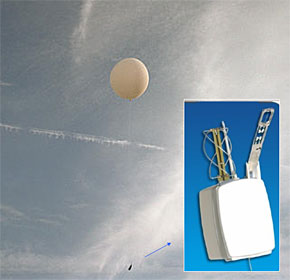Improved Radiosonde Sensor Ready for Launch
Published: 15 February 2005

As part of the Balloon Borne Sounding System, radiosondes launched at the the ARM Climate Research Facility sites are supplied by Vaisala, one of the market leaders of this technology. Vaisala began phasing out production of the RS90 radiosondes at the end of calendar year 2004 in favor of their new RS92 model. The new version has an improved global positioning system processor that will increase the accuracy of the wind speed and direction measurements made during the balloon flight. It also uses a new digital telemetry system to reduce the potential for data loss, and includes a system for restoring the temperature and humidity sensors to their factory-calibrated condition before flight to improve the measurement of these important variables. This winter, the ARM Climate Research Facility operations personnel worked to upgrade the various firmware and hardware systems at the radiosonde ground stations for compatibility with the new sondes.
The radiosonde system was one of the first instruments deployed by the ARM Climate Research Facility; the first launch was conducted on May 27, 1992, from the Southern Great Plains (SGP) site, using a then state-of-the-art ground system known as the PC-CORA. Since then, the ARM Climate Research Facility pioneered the use of three subsequent generations of radiosonde ground systems, as technological advances led to the Digi-CORA I, II, and III models. With the transition to the RS92 radiosondes, the PC-CORA will be retired after nearly 13 years of continuous service, and the other systems upgraded to accommodate the new sensor packages.
In January 2005, operators at SGP received training from the ARM Climate Research Facility instrument mentor in the use of the new RS92 sondes. Launches with the new sondes began in February at the SGP site, and will begin in March for the ARM Mobile Facility deployment in Point Reyes, California. Launches for the ARM Climate Research Facility Tropical Western Pacific and North Slope of Alaska locales will be phased in as they exhaust their stocks of RS90 sondes.
The ARM Climate Research Facility is a DOE Office of Science user facility. The ARM Facility is operated by nine DOE national laboratories, including .
Keep up with the Atmospheric Observer
Updates on ARM news, events, and opportunities delivered to your inbox
ARM User Profile
ARM welcomes users from all institutions and nations. A free ARM user account is needed to access ARM data.


















